
Those who plan to travel to Death Valley National Park in the near future, may want to make alternative plans, as much of the park remains closed from the Trona/Wildrose Junction in Panamint Valley, through Death Valley Junction.
Highway 190 is still shut down due to flood damage from last month’s torrential rainstorms, but the National Park Service said those areas are expected to open no earlier than Aug. 19, as work continues to clear debris and repair the roads.
According to a Death Valley press release, the partial opening allows for access to limited areas, including Panamint Springs Resort, Father Crowley Overlook and Lee Flat.
“The most highly visited areas of the park, including the Furnace Creek Visitor Center, Badwater Basin, Zabriskie Point, Dantes View, Mesquite Sand Dunes, and additional paved roads remain closed due to extensive flood debris and damage,” the release noted. “While areas of the park are still wet and muddy following (the) storm, it is important to give these areas time to dry out. Walking onto wet playas can leave footprint scars for years to come and driving on muddy dirt roads can cause deep ruts adding to the damage and time to repair these areas.”
The release also stated that some navigational apps are routing travelers onto primitive backcountry dirt roads to avoid the paved road closures.
Additionally, park rangers have routinely responded to aid stranded motorists in the area.
“Some had all four tires on their vehicle flat,” according to officials. “Park staff have been diverted from flood operations to start re-searching backcountry roads, add additional closures signs, and respond to stranded visitors. No injuries have been reported.”
Park Superintendent Mike Reynolds urges visitors to stay off dirt roads, even if apps are directing them there.
“While we are working with various map platforms to report these issues, please be smarter than your smart phones,” he cautioned.
The release went on to state that backcountry dirt road travel is strongly discouraged in the summer under normal conditions, as there is increased risk of being stranded in a remote location in extreme heat.
“According to the National Weather Service, temperatures in Death Valley have been between 114 and 117 degrees in the past few days,” according to the release, “Those temperatures are forecasted to continue in the 111 to the 114 range. At this time, all dirt roads that have been assessed have had damage, and some are unpassable. Not all roads have been assessed for current conditions due to the scale of the flooding impacts.”
As areas slowly reopen, officials said conditions will be updated on the park’s website.
To access the park’s website, login to www.nps.gov/deva.
Funding to help Death Valley roads
Nearly $12 million has been freed up for the National Park Service to repair flood damage to roads in Death Valley National Park, the U.S. Department of Transportation’s Federal Highway Administration announced Monday.
U.S. Transportation Secretary Pete Buttigieg said in a statement that the $11.7 million in emergency relief funding will allow roads to reopen quickly.
“This level of disaster, formerly considered an every-thousand-year phenomenon, gives us renewed urgency in the steps we’re taking to fight the climate crisis and to make our infrastructure more resilient.”
Elsewhere in the Southern California deserts, floods linked to this summer’s very active monsoon season have also damaged roads in the Mojave National Preserve and Joshua Tree National Park.
Contact reporter Selwyn Harris at sharris@pvtimes.com. On Twitter: @pvtimes